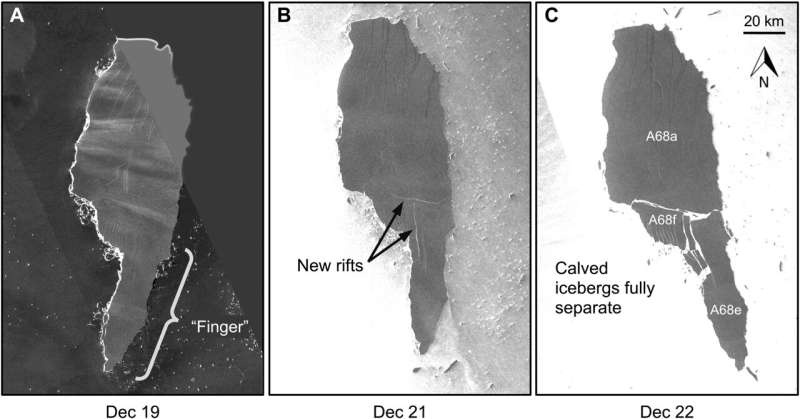Sentinel-1 imagery of iceberg A68a. (A) December 19 (partial image). (B) December 21. (C) December 22. The full separation of the calved finger is apparent on December 22 (C) but was preceded by new rifting on December 21 (B) that was previously absent on December 19 (A). Credit: Science Advances (2022). DOI: 10.1126/sciadv.abq6974
A team of researchers at Princeton University, working with a colleague at City University of New York, has found evidence suggesting that the reason a large portion of iceberg A68 broke away back in 2020 was that it encountered shear forces due to differences in ocean currents. In their paper published in the journal Science Advances, the group describes their study of satellite images of the iceberg and the model they built to test their theory regarding why it broke apart.
In 2017, iceberg A68 was born when it broke away from the Larsen C ice shelf. At approximately 5,890 square kilometers, it was one of the largest icebergs ever observed. Three years later, parts of the iceberg broke away when its underside struck the ocean floor. Then, a few months later, a finger representing nearly half its length broke away for unknown reasons. In this new effort, the researchers sought to find out the reason for the second break.
The work involved studying satellite images of the iceberg and data from other sources that showed what was happening in the Southern Ocean at the time. The researchers found what looked like a shearing incident. The iceberg moved from a slow-moving current into a faster-moving cross-current. Resulting shear forces exerted pressure on the finger portion of the iceberg, breaking it away. To test their theory, the researchers used a model called Kinematic Iceberg Dynamics to simulate the conditions in the ocean at the time of the second breakaway. It showed that such shear forces could, indeed, have led to the finger break.
The researchers note that learning more about what happens to icebergs as they travel south is important because as the planet warms, more of them will be released and set adrift. And because some of them are so big, huge amounts of freshwater will be released into the sea as they melt. Meltwater, they note, can exert an influence on ocean circulation and stratify water columns. It can also have a major impact on phytoplankton because as the ice melts, massive amounts of iron are released into the sea.
More information: Alex Huth et al, Ocean currents break up a tabular iceberg, Science Advances (2022). DOI: 10.1126/sciadv.abq6974
Journal information: Science Advances
© 2022 Science X Network






















